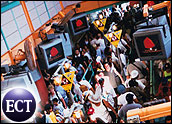
General Motors and Ford suffered declining U.S. sales in August. Each announced Wednesday that it will cut production in the fourth quarter, risking profitability for the calendar year.
Chrysler, on the other hand, beat the bum month experienced by its competitors with its fifth straight month of sales increases. Since Chrysler managed to bump sales by 1 percent in August, analysts said, its rivals must find a way to reengage consumers with their brands.
While most makers remain wedded to sales incentives, a few are taking a bolder approach to attracting new customers and keeping the old ones.
GM’s Response
GM announced that it would cut its 2004 fourth-quarter production by 6.8 percent. It did not announce any production guidance for beyond the fourth quarter.
It expects fourth-quarter sales to rebound with the release of new models and the launch of its new “crossover sport vans,” such as the Saturn Relay and Chevrolet Uplander.
Although the company does not announce sales incentives in advance, they are likely to remain part of the company’s strategy. “While we have seen some leveling off of the lift from incentives, these programs still appeal to a large group of consumers and are an importantpart of our overall marketing strategy,” said GM spokesperson Deborah Silverman.
Incentives Lose Luster
Recent findings from Maritz Automotive Research in St. Louis show incentives and rebates decreasing in their relevancy to automobile purchase decisions.
Maritz’s 2004 New Vehicle Customer Study reports that the average size of rebates and incentives has grown 10 percent each year since 2002, with the biggest jump occurring among domestic manufacturers.
Consumers, however, have grown less interested in incentives. Car buyers have failed to jump at cash-back or a customer loyalty offerings aimed at repeat buyers, so manufacturers are getting fewer long-term benefits from incentives.
VW’s Theme Park
Joe Pine, cofounder of Ohio’s Strategic Horizons and co-author of The Experience Economy, hopes rebates and incentives will go away altogether.
“A big part of the problem is that the auto manufacturers have taught their customers to buy on price, so they’re basically commoditizing themselves,” he told CRM Buyer. “Many manufacturers and dealers are getting around that by building an experience.”
Volkswagen offers a very profitable theme park outside of its first German factory, charging visitors 10 to 15 euros (US$15 to $20) for entry and then selling them on the brand, Pine said.
Different areas of the park feature different VW brands — Audi, Lamborghini, VW and Bentley. A factory tour and movies about Volkswagen production top off the trip, and European VW buyers can pick their cars up at the site, viewing their new autos from a distance as they approach a huge glass tower showing off the new vehicles.
“The unique delivery experience increases the likelihood customers will buy the brand again,” said Pine.
The Dealership as Theater
Toyota has the Mega Web theme park in Tokyo, and Ford recently revamped the customer experience at its River Rouge, Michigan, plant with a new multimedia presentation.
Dealerships have entered the experience arena, too, Pine said. Planet Ford in Texas offers an Internet cafe and other products that draw incremental revenue from car buyers, much as the manufacturers’ theme parks do.
Audi has created a new type of dealership design that resembles an airline hangar. In a rare case of close cooperation between manufacturer and dealer, Audi offers design and strategic assistance to interested dealers.
According to Pine, carmakers and dealers should abandon incentives in favor of the theme-park approach. “Incentives are like a drug,” he said, “and the only way to get off a drug is cold-turkey.”
Not So Fast
But Mike House, director of the automotive market analysis group at Maritz Research in Ohio, doesn’t advocate the withdrawal of incentives.
“As far as cash incentives and rebates, we’re not saying they don’t work. We’re just saying they’re less effective,” he told CRM Buyer. “They still need to be a part of the mix.”
House said that the influence of rebates and incentives on customers’ choice is declining for all but the Korean manufacturers. He added, however, that Chrysler’s August increase most likely resulted from a combination of extended power-train warranties, rebates and popular new products.
The decline in the impact of incentives from 2002 to 2004 is most evident among domestic manufacturers, with only 30 percent of customers in 2004 citing incentives or rebates as a reason for purchase timing, down from 40 percent in 2002.
“Incentives have grown since 9/11,” House said. “There is less concern among consumers about taking incentives right now.” In other words, incentives have become so common that buyers expect them to continue and therefore feel no pressure to buy now.
Hearts and Minds
“A number of large automakers are trying to wrestle with this issue,” commented John Fleming, senior strategic consultant for Gallup in Princeton, New Jersey. “In the short-term, it’s not clear what they can do to turn sales around this year.”
But in the long term, he said, auto manufacturers have to move beyond customer satisfaction. “The number one way of assessing the customer experience is fundamentally flawed,” he said. “Customer satisfaction is a flawed measure to be driving your business by, because it doesn’t necessarily mean repurchase or a loyalty to a make or model.”
Smart auto marketers “are trying to get to something more fundamental in the hearts and minds of customers,” according to Fleming. “Manufacturers recognize that they need to create stronger emotional experiences with customers rather than very functional connections.” Sales incentives might act as short-term buoys to sales, but they certainly do not serve to differentiate a brand.










































